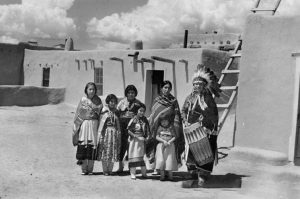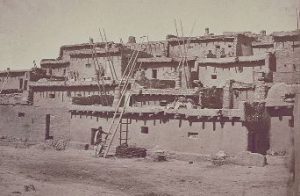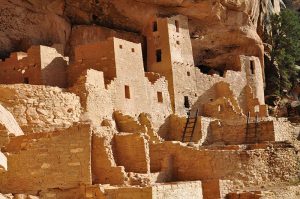 Most often, when we think of the early Americans, and their settlements, we think about the settlers who came over from Europe, but there were, of course, the many Indian tribes that existed here first. I’m not going to dispute whether the Indians or the White Man have more right to be here, because I truly believe that we should all be able to co-exist here after all these years, and that while treaties were broken many times, we have more than likely paid for this land a number of times, given the money that has been, and continues to be paid to the Native Americans. The oldest known culture in the United States was the Pueblo Indians, who lived in the Southwestern United States. Their name is Spanish for “stone masonry village dweller.” They are believed to be the descendants of three major cultures…the Mogollon, Hohokam, and Ancient Puebloans (Anasazi) Indians. I’m not sure how they would have come to be here, unless their ancestors were here first, but that is how the historians see it.
Most often, when we think of the early Americans, and their settlements, we think about the settlers who came over from Europe, but there were, of course, the many Indian tribes that existed here first. I’m not going to dispute whether the Indians or the White Man have more right to be here, because I truly believe that we should all be able to co-exist here after all these years, and that while treaties were broken many times, we have more than likely paid for this land a number of times, given the money that has been, and continues to be paid to the Native Americans. The oldest known culture in the United States was the Pueblo Indians, who lived in the Southwestern United States. Their name is Spanish for “stone masonry village dweller.” They are believed to be the descendants of three major cultures…the Mogollon, Hohokam, and Ancient Puebloans (Anasazi) Indians. I’m not sure how they would have come to be here, unless their ancestors were here first, but that is how the historians see it.
Over the years, the Ancient Puebloans, who had been a nomadic, hunter-gathering society, evolved into a sedentary culture. They made their homes in the Four Corners region of Colorado, New Mexico, Utah and Arizona. The Puebloans continued to hunt, but they also expanded to agriculture. They grew maze, corn, squash, and beans. They also raised turkeys and even developed a fairly complex irrigation system. They took up basket weaving and pottery, and became quite skilled in both. About this time, they began building the  buildings we think about when we think of the Pueblo Indians…villages, often on top of high mesas or in hollowed-out natural caves at the base of canyons. These multiple-room dwellings and apartment like complexes, designed with stone or adobe masonry, were the forerunner of the later pueblos.
buildings we think about when we think of the Pueblo Indians…villages, often on top of high mesas or in hollowed-out natural caves at the base of canyons. These multiple-room dwellings and apartment like complexes, designed with stone or adobe masonry, were the forerunner of the later pueblos.
Sadly, even with their successful life changes, the Ancient Puebloans way of life declined in the 1300’s, probably due to drought and inter-tribal warfare. They migrated south, primarily into New Mexico and Arizona, becoming what is today known as the Pueblo people. For hundreds of years, these Pueblo descendants lived a similar lifestyle to their ancestors. They continued to survive by hunting and farming, and also building “new” apartment-like structures, sometimes several stories high. These new structures were made of cut sandstone faced with adobe, which is a combination of earth mixed with straw and water. Sometimes, the adobe was poured into forms or made into sun-dried bricks to build walls that are often several feet thick. The buildings had flat roofs, which served as working or resting places, as well as observation points to watch for approaching enemies and view ceremonial occasions. For better defense, the outer walls generally had no doors or windows, but instead, window openings in the roofs, with ladders leading into the interior.
 Each family unit consisted of a single room of the building unless the family grew too large. Then side-rooms were sometimes added. The houses of the pueblo were usually built around a central, open space or plaza in the middle of which was a “kiva,” a sunken chamber used for religious purposes. Each pueblo was an independent and separate community. The different pueblos shared similarities in language and customs, but each pueblo had its own chief, and sometimes two chiefs, a summer and winter chief, who alternated. Most important affairs, such was war, hunting, religion, and agriculture, however, were governed by priesthoods or secret societies. Each pueblo was almost a separate country.
Each family unit consisted of a single room of the building unless the family grew too large. Then side-rooms were sometimes added. The houses of the pueblo were usually built around a central, open space or plaza in the middle of which was a “kiva,” a sunken chamber used for religious purposes. Each pueblo was an independent and separate community. The different pueblos shared similarities in language and customs, but each pueblo had its own chief, and sometimes two chiefs, a summer and winter chief, who alternated. Most important affairs, such was war, hunting, religion, and agriculture, however, were governed by priesthoods or secret societies. Each pueblo was almost a separate country.


One Response to Pueblo People